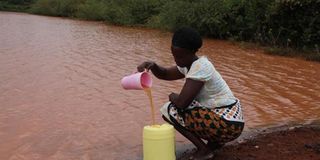Water funds are a novel way to deliver sanitation and save lives

A woman collects water from a water pan in Siaya County. FILE PHOTO | TOM OTIENO |
What you need to know:
- The World Bank’s water and sanitation programme estimates that lack of water and sanitation causes a downward pull on GDP of between 2-7 per cent annually.
- Kenya is classified by the United Nations as a water-scarce country where less than one-third of the population has access to an improved water source.
As the United Nations Secretary General Ban Ki-moon once said, our world is one of terrible contradictions.
While we have an overabundance of food in some quarters, one billion people go hungry every day.
A few people live a lavish lifestyle while poverty is the reality for billions of others. And while the world has made tremendous advances in medicine, women in the developing world still die in childbirth, and children from drinking dirty water.
Africa faces severe challenges in accessing clean water and sanitation, and Kenya is no exception. Inability to access clean water, sanitation, and hygiene is one of the greatest obstacles to poverty alleviation and economic growth in many countries.
The World Bank’s water and sanitation programme estimates that lack of water and sanitation causes a downward pull on GDP of between 2-7 per cent annually, while providing water and sanitation has a reciprocal positive impact on GDP.
Worldwide, about 748 million people, 325 million of whom live in sub-Saharan Africa, still lack access to safe water. Twenty-eight of the 38 countries with the lowest levels of access to an improved drinking water source are located in sub-Saharan Africa.
We are warned that if nothing is done by 2025, nearly two-thirds of the world’s population will be water-stressed due to greater demands on fresh water resources by burgeoning human populations, the diminishing quality of existing water resources because of pollution, and the additional requirements of servicing our industrial and agricultural growth.
These statistics tell us that it is time to invest in water and protection of water resources if we are to attain sustainable development. No technological advancement can replace water in the foreseeable future, and so we need to invest heavily in securing what precious water supplies we have.
The responsibility of delivering access to clean water to communities demands a broad-based approach involving the Golden Triangle approach, which brings together the government, NGOs, and private companies to address this issue. Here is why.
The concept of water funds is one that could help in achieving this. A water fund is an innovative tool that pays people to protect nature’s services. I believe that introducing this tool in sub-Saharan Africa could go a long way towards addressing this broad issue.
WATER-SCARCE
Kenya is classified by the United Nations as a water-scarce country where less than one-third of the population has access to an improved water source.
Although the country does have the water resources it needs to meet demand, water quality is poor and drought impacts are amplified by unsustainable land-use practices.
As the population grows and farming intensifies, the wetlands that store water are disappearing and sediment runoff is polluting our watersheds.
The Nairobi Water and Sewerage Company reports that during the wet season, water treatment costs often increase by more than 33 per cent as sediment runoff fills and chokes treatment equipment. To offset the increased costs, funding is diverted from activities that expand the city’s water distribution or promote water availability for marginalised urban neighbourhoods.
Secondly, since a healthy watershed minimises water treatment costs, large, downstream users willingly contribute to a water fund as a way of shoring up their business investment.
Revenues from the fund are used to promote sustainable management practices in lands upstream that filter and regulate the water supply. Funding is also used to create incentives for sustainable economic opportunities that enhance livelihoods and the quality of life for upstream communities.
Investment in improved water will also reduce other societal costs such as malnutrition, diarrhoea, and cholera.
The concept of water funds has been proven to work in other nations, especially in Latin America’s Mexico, Ecuador, and Colombia. With support from the Inter-American Development Bank and bottling companies, six other funds are being developed in the region.
The writer is president, The Coca-Cola Africa Foundation. [email protected].





